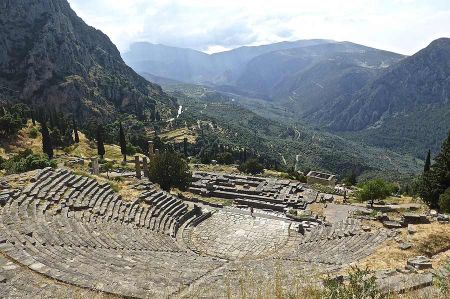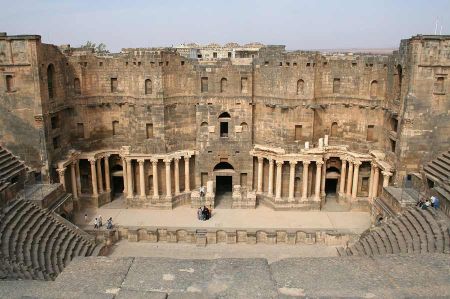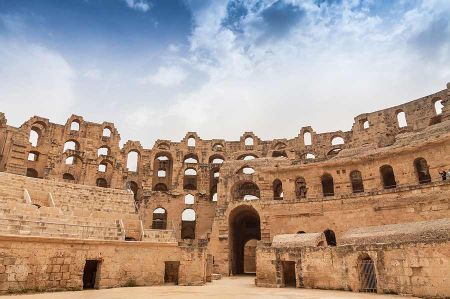In our articles we often talk about ancient Roman and Greek theatre buildings that we visited and described as part of our project. However, the names of the buildings sometimes lead to confusion, which is why we would like to make the following terminological clarification and the background to it (in the Picture Theatre in Syria).
The original Greek theatre as an acting activity emerged as a religious stage from the cult of the god Dionysus in the 6th century BC, which included choral singing, ecstatic dances and masked parades.
Performance practice of the theater actor
 The combination of cult and play gives rise to the first two forms of drama: tragedy and comedy, which are performed twice a year for the people at the Dionysus celebrations in Athens. As a competition of dramatic games with prizes awarded to the best actors, the theatre developed into a state institution. Under the ruler Pericles, poor citizens even received theatre money to compensate for the loss of income caused by attending the theatre (in the picture Theatre Delphi). The setting for these performances was initially only the sanctuary of Dionysus on the southeastern slope of the Acropolis. The later form of Greek theatre construction emerged from the performance practice of theatre acting.
The combination of cult and play gives rise to the first two forms of drama: tragedy and comedy, which are performed twice a year for the people at the Dionysus celebrations in Athens. As a competition of dramatic games with prizes awarded to the best actors, the theatre developed into a state institution. Under the ruler Pericles, poor citizens even received theatre money to compensate for the loss of income caused by attending the theatre (in the picture Theatre Delphi). The setting for these performances was initially only the sanctuary of Dionysus on the southeastern slope of the Acropolis. The later form of Greek theatre construction emerged from the performance practice of theatre acting.
The ritual dance place in front of the Temple of Dionysus
 The playing area is the Orchestra, the ritual dance area in front of the Temple of Dionysus. The choir performs singing and dancing on it. A light wooden frame, the Skene, separates the orchestra from the open back and indicates the location of the action for the individual performances. Initially renewed for each game, a permanent wooden structure is later created that includes a stage wall with movable elements (in the picture Theatre in Syria). Stone stage buildings were not built until the 4th century. The auditorium, called theatron in Greek and cavea in Roman, initially encloses the orchestra in a trapezoidal shape. Only later does the typical semicircular structure with increasing squares develop, initially on wooden structures. Unfortunately, there is only very sparse documentation of theatre construction from pre-Christian times, the heyday of classical playwrights. The few surviving fifth-century Greek theatres are all rectangular in shape.
The playing area is the Orchestra, the ritual dance area in front of the Temple of Dionysus. The choir performs singing and dancing on it. A light wooden frame, the Skene, separates the orchestra from the open back and indicates the location of the action for the individual performances. Initially renewed for each game, a permanent wooden structure is later created that includes a stage wall with movable elements (in the picture Theatre in Syria). Stone stage buildings were not built until the 4th century. The auditorium, called theatron in Greek and cavea in Roman, initially encloses the orchestra in a trapezoidal shape. Only later does the typical semicircular structure with increasing squares develop, initially on wooden structures. Unfortunately, there is only very sparse documentation of theatre construction from pre-Christian times, the heyday of classical playwrights. The few surviving fifth-century Greek theatres are all rectangular in shape.
Only the following components are considered to be largely scientifically certain for the fifth century (in the picture Colosseum Roma):
Theatron (initially made of wood, later made of stone),
Skené (wooden stage house, hence also "scene"),
Orchestra, the playing area for choir and actors,
Parodoi, the two side entrances to the Orchestra,
Ekkyklema, a platform that was rolled out of the house to visualize behind-the-scenes scenes within the house in a tableau,
Mechane, a crane with which the deus ex machina seemingly floated down onto the stage and intervened in the tragic events.
The theatre quickly spread beyond the borders of Athens and the first specially built theater buildings were built. After many negative experiences with wooden stands, the first open-air theatres are built, which are often integrated into hillsides and have a north-south orientation. Pits dug in front of the orchestra facilitate the creation of rising steps in a ring shape for visitors (in the picture Colosseum Roma). They enable an even view from all seats and have a positive influence on the acoustics. The Greeks achieved the ideal form of theatre by concentrating on the main elements mentioned and their geometry. Around 420 in Athens, the orchestra was removed from the context of the temple and altar and a concentric structure was created. The expansion with stone material then takes almost a century.
Temple construction with its autonomy from nature
The Theatre of Epidaurus, which was built in the 3rd century because of its perfection, is considered a typical example of ancient Greek theatre construction. The length of the slope used meant that retaining walls were only necessary in the lower area (in the picture Amphitheatre in Pula). By merging the geometrically pure art form with the open landscape, Greek architecture in theatre construction achieved a counter position to the monstrous temple construction with its autonomy from nature. The early Romans in particular adopted the basic architectural concept of the Greeks in their first theatre buildings.
To this day, scientists are still arguing about whether the amphitheatres that then developed can be traced back to the joining of two semicircular theatres, or at least that is what older research describes. Researchers now tend to assume that the amphitheatre, as a venue for gladiator fights, underwent a structural development independent of the theatre. Only in the construction of the auditorium, the cavea, are there clear borrowings from ancient Greek theatre construction.
Amphitheaters often have sophisticated stage technology
In the Roman Empire, the amphitheatres were venues for gladiatorial and animal fights (munera et venationes), but also for large theatrical performances and sporting competitions (in the picture Amphitheatre in Arles). They were used to keep the people entertained according to the motto “bread and circuses”. Amphitheatres often had sophisticated stage technology with which the structures could be lowered underground or they could even be completely filled with water.
During Caesar's time, amphitheatres in Rome were built from wood and torn down after the competitions. Around 27 AD, such a tribune collapsed in Fidenae (east of Rome), killing thousands of people. This meant that in the future, stands were only allowed to be built on solid ground, until stone amphitheatres were finally used. However, stone amphitheatres already existed in Campania in the late Republic.
The oldest theatre of this type (around 70 BC) was found in Pompeii. The name with the Greek word amphitheatre was first found in Strabo, and Flavius Josephus also mentioned it in connection with Herod's building work around 25 BC (in the picture Amphitheatre Verona). The oldest mention of the word in Greek comes from the Libyan Berenike from around 8 to 6 BC. The largest amphitheatre in antiquity was the Flavian Amphitheatre, later called the Colosseum, in Rome, which could accommodate up to 50,000 spectators. The ascending tiers of the theatre were called Maenianum. Viewers placed big bets on their fighters and became very invested in them. This often led to Rivalries and Argumentation.
Please read as well:
Nepomuk – not just a well-known dragon that no one wants
Split visit to the Bralić family shows caravan aftereffects


